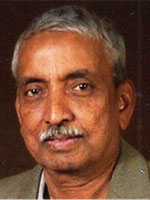
Twenty First Century Global Anthropogenic Warming Convective Model
Please plan on attending this seminar. It could really impact your research. Dr. Neale R. Neelameggham is a technical visionary at IND LLC.
The seminar will be from 3:00 to 4:00 p.m. on Wednesday September 2, in WEB L102. There will be light refreshments afterwards.
Abstract:
Authors: Neale R. Neelameggham and Brian R. Davis
As today’s world is rapidly increasing in using alternative energy, we should realize what happens to that energy generated and dissipated. Alternative energy resources are again man-made or anthropogenic. These energy conversions are still mainly for electricity – for heating and cooling or lighting or for work involving movement or for chemical and metallurgical processes, all of which again create thermal wastes. These are independent of fuel or alternative energy. Present day correlations will become obsolete in explaining atmospheric temperature variations when more and more renewable energy is used to create electricity which in turn creates thermal emissions in the future. However, the convective model in this paper addresses these and discusses the effect of these thermal wastes into atmosphere –which can lead to climate change, as excess precipitation. Our model does not compute the ‘nano particles’ or cloud seeding which may be required. The extent of thermal waste is a function of population. Energy efficiency in conversion and usage can help moderate some of this. The convective model will show that evapo-transpiration changes play a major role in the atmospheric air mass constrained climate change. The extent of global mean temperature increase is a function of sinusoidal variances in solar influx as noted by several scientists; the excess precipitation computations will fit any of the global mean temperature assumptions – from small to large increases.
Biography:
Neale R. Neelameggham is ‘The Guru’ at IND LLC, involved in Technology marketing and international consulting in the field of light metals and associated chemicals [boron, magnesium, titanium, lithium and alkali metals, rare earth elements, battery and energy technologies, etc. He has been a senior consultant for global engineering companies on various metal and chemical processes. In 2012 he was a visiting expert at Beihang University of Aeronautics and Astronautics, Beijing, China. Neale has been an advisor for several other metal production and energy process firms.
He has over 38 years of expertise in magnesium production technology from the Great Salt Lake Brine in Utah, involved in process development of its startup company NL Magnesium through to the present US Magnesium LLC from where he retired. Dr. Neale Neelameggham was instrumental in most of the process and equipment development of all areas of the plant from the raw material source – the Great Salt Lake Brine, which is concentrated by solar evaporation into a plant feed, which was further purified of impurities, followed by spray drying and preparation of anhydrous magnesium chloride cell feed to electrolytic cells and then into magnesium metal product and chlorine.
In addition, Dr. Neelameggham’s expertise includes an in-depth and detailed knowledge of all competing technologies worldwide of magnesium production, both electrolytic [worldwide cell designs] and thermal processes, as well as alloy development.
Dr. Neelameggham holds 13 patents and patent applications on sustainable light metal production. He has several technical papers to his credit. As a member of TMS, AIChE, and a former member of American Ceramics Society he is well versed in energy engineering, bio-fuels, rare-earth minerals and metal processing and related processes. He has served in the Magnesium Committee of LMD since its inception in 2000, chaired it in 2005, and in 2007 he was made a permanent co-organizer for the Magnesium Symposium. In 2008, LMD and EPD created the Energy Committee following the symposium on CO2 Reduction Metallurgy Symposium initiated by him. Dr. Neelameggham was the inaugural Chair for the Energy Committee. He has been a co-editor of the Energy Technology symposium since 2008 through the present. He received the LMD Distinguished Service Award in 2010. Dr. Neelameggham holds a doctorate in extractive metallurgy from the University of Utah. Neale was the Chairman of Hydrometallurgy and Electrometallurgy Committee, Extraction & Processing Division, TMS for 2013-2015 term where he organized the Rare Metal Technology 2014 and 2015. He is the co-editor for the Essential Readings in Magnesium Technology compendium from TMS papers published in 2014.
He and Dr. Brian Davis have published articles on ‘Convective heat transfer models for global anthropogenic warming – GAW’ which is a precursor for the talk he is going to present today.